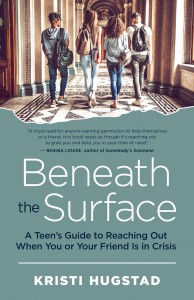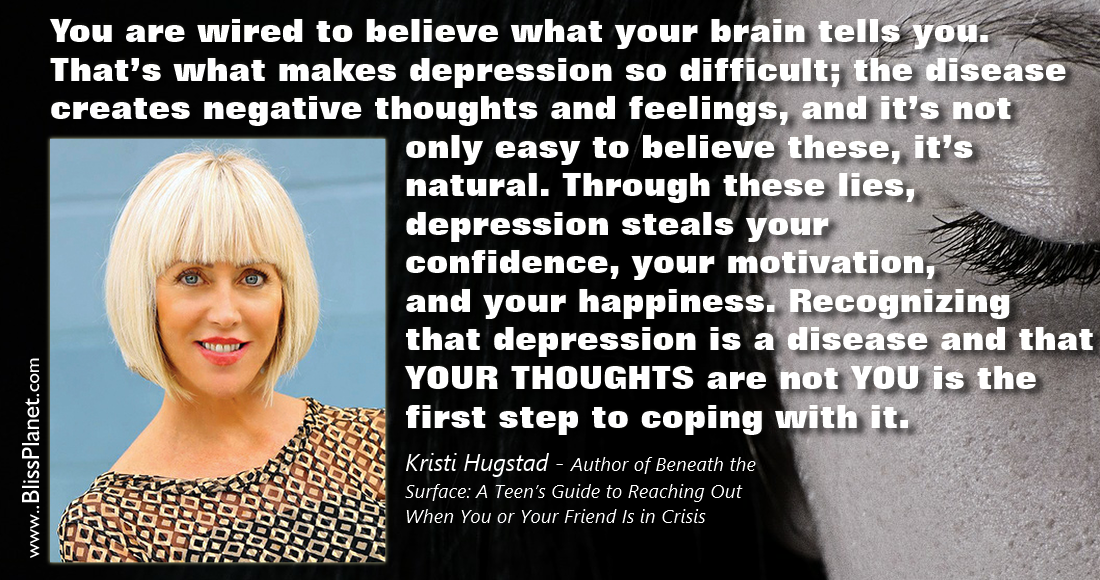While growing up has never been easy, today’s teens face unique challenges. In addition to dealing with cliques and peer pressure, they live in a fast-changing social media world that exposes and makes vulnerable as much as it connects. Factor in mass shootings, daily reports about climate change, and the prospect of crippling debt from college loans, and it’s no wonder that rates of teen depression, anxiety, and, tragically, suicide are soaring.
In Beneath the Surface: A Teen’s Guide to Reaching Out When You or Your Friend Is in Crisis (New World Library, September 3, 2019), author Kristi Hugstad talks with, rather than down to, teens, about issues like depression, eating disorders, PTSD, anxiety, bullying, substance abuse, suicide, and more, and encourages them to reach out for help when they need it. We hope you’ll enjoy this Q and A with Kristi about the book.
What inspired you to write Beneath the Surface?
When my husband, Bill, completed suicide, he shattered both of our lives. In the tunnel of unfathomable grief, I found that my only path forward was to dedicate my life to helping prevent this kind of tragedy from happening to others. Unfortunately, we live in a world where suicide have become commonplace – at every age and in every demographic. Teens, specifically, are experiencing an unprecedented mental health crisis – one with no foreseeable cure except education and awareness. Speaking to our teens, teachers, parents and administrators about mental illness and suicide doesn’t simply provide education; it can lead to early intervention and, with all our help, save precious lives.
What is the most important thing for teens to know when experiencing a crisis?
Speak up. Call a friend, see a professional, talk to your parents. There is nothing so bad or so shameful that you can’t get help for it. No matter how much you isolate yourself, you are not alone. Reach out and help will come.
What advice or perspective do you have to offer parents or educators who want to help a teen who is in crisis but aren’t sure how?
Education is key. Had I known the risk factors and warning signs of suicide, I would have seen just how serious my husband’s situation had become. When you’re familiar with the signs and symptoms, you’re empowered to act when you need to. Asking important, direct questions – have you thought about taking your life? Do you have a suicide plan? – is imperative, as is listening to the answers with love and without judgment.
You say in the book that depression that depression is a thief and a liar. What do you mean by that?
You are wired to believe what your brain tells you. That’s what makes depression so difficult; the disease creates negative thoughts and feelings, and it’s not only easy to believe these, it’s natural. Through these lies, depression steals your confidence, your motivation, and your happiness. Recognizing that depression is a disease and that your thoughts are not you is the first step to coping with it.
Do you have some coping strategies you can offer for those who are struggling with depression?
Stay connected. Isolation will only exacerbate your depression. Make an effort to talk to friends or participate in social activities – even if you don’t feel like it. Find ways to help others. Do what makes you feel good – hobbies and favorite pastimes are instrumental in coping with depression. Take care of your body by eating right, exercising, spending time outside and getting plenty of sleep. Challenge negative thoughts when they come – put them on the witness stand and cross-examine them before you believe them. If you feel your symptoms worsen, don’t suffer needlessly and alone. Get professional help.
You say in the book that social media can feed the fears that lead to depression and a sense of hopelessness. How so?
Social media often presents picture-perfect lives that no one can actually live up to. Believing that social media portrays reality can lead to feelings of inadequacy and anxiety. Teens who suffer from poor body image often use social media photos and posts as confirmation of their own inadequacy. Social media is also a big contributor to bullying, providing public and private means for bullies to taunt and shame their victims. Furthermore, excessive use of technology – whether smartphones, computers or gaming systems – can lead to addiction, confining teens to their bedrooms to live in a fictional world. Technology addiction can cause and contribute to depression in all ages, but particularly in teens.
What are some of the warning signs of suicide and what is the best thing for someone to do when/if they are having suicidal thoughts?
Knowing the warning signs of suicide can be instrumental in saving a life. Abusing substances, eating and/or sleeping much less or much more than usual, withdrawing from family and friends, engaging in reckless or rebellious behavior, talking about suicide, giving away personal belongings, showing indifference to academic work and grades, displaying a decline in personal hygiene, engaging in sexual promiscuity and researching methods for suicide can all be big signs that someone is at risk of suicide. Tell an adult you trust immediate who can help you intervene.
What do you most hope readers will take away from your book Beneath the Surface?
Suicide prevention is my life’s mission, but I can’t do it alone. Abolishing the stigma surrounding mental illness takes everyone’s help. Teens, along with their parents, teachers, administrators – and anyone else who cares about them – must understand mental illness and recognize the warning signs and risk factors for depression and suicide. Continually encouraging teens to reach out for help and addressing their struggles through direct, honest conversations is the only way to save lives today and in generations to come.

Kristi Hugstad is the author of Beneath the Surface: A Teen’s Guide to Reaching Out when You or Your Friend Is in Crisis and What I Wish I Had Known, which addresses her husband’s suicide. A certified grief recovery specialist and a grief and loss facilitator for recovering addicts at South Coast Behavioral Health, Kristi frequently speaks at high schools. She is also the host of The Grief Girl podcast and lives in Orange County, California. Visit her online at www.thegriefgirl.com.
Special thanks to New World Library





